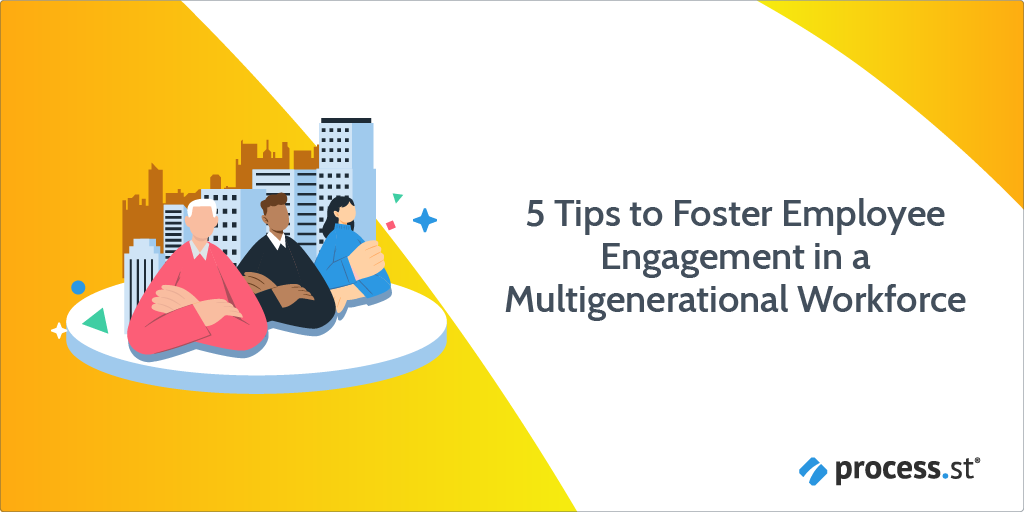
86% of companies believe a multigenerational workforce is the key to success.
This success is due to a diverse workforce giving organizations more problem solving, varied perspectives, and diverse skills. This Process Street article will help you optimize and engage employees of all ages. At the end of the post, I’ll tell you about a secret famous butler I met in a multigenerational workforce.
Here’s how to understand and engage a multigenerational workforce:
- What is a multigenerational workforce?
- The strengths and weaknesses of each generation
- Five tips for engaging a multigenerational workforce
What is a multigenerational workforce?
A multigenerational workforce comprises five different generations. The term “Generation” was used in the second half of the nineteenth century to suggest the contrast between older and younger people. These are the generations in a modern workforce:
- Traditionalists: Born between 1927 and 1946
- Baby Boomers: Born between 1946 and 1964
- Generation X: Born between 1965 and 1980
- Generation Y (Millennials): Born between 1980 and 1995
- Generation Z: Born between 1995 and 2010
The ideas and methods of the above generations are as diverse as their ages. However, understanding each generation is essential to ensure communication and collaboration.
The strengths and weaknesses of each generation
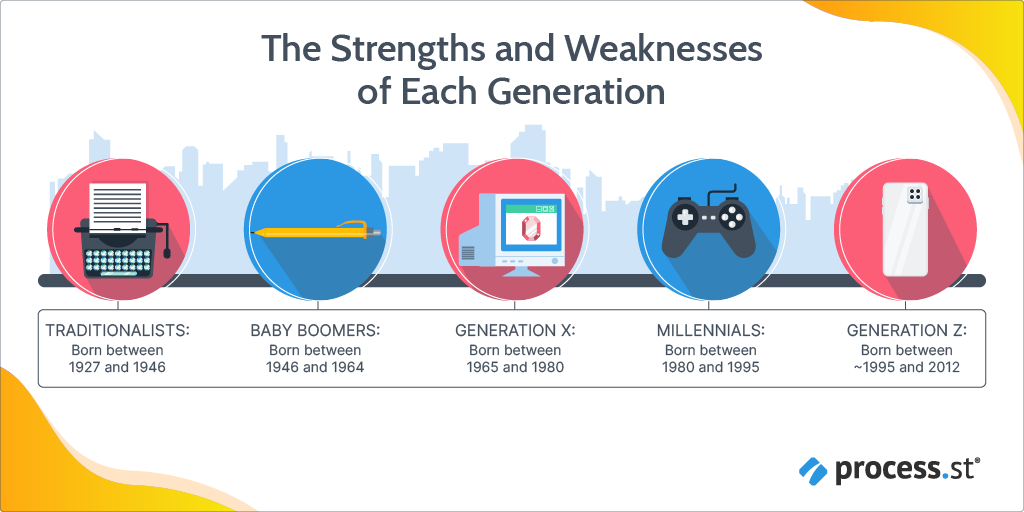
Each generation has different strengths and weaknesses. Every generation contains individuals with unique personality types and ways of completing tasks. It helps to remember that some people work harder than others and in different ways, despite being of the same age.
Traditionalists’ strengths include being:
Two weaknesses attributed to Traditionalists are being inflexible and uncomfortable with change.
Baby Boomers are known to have:
Criticisms of Baby Boomers are that they need recognition to motivate them. They are also less tech-savvy than Generation X, Y, and Z.
Generation X is known for:
Their shortcomings are said to be cautiousness, conservativeness, and being too self-reliant.
Millennials are known to be:
The one complaint of Millennials is that they lack focus.
Generation Z is known for being:
Generation Z is considered more cynical than Generation Y and too reliant on technology to solve problems.
Multigenerational workforce benefits
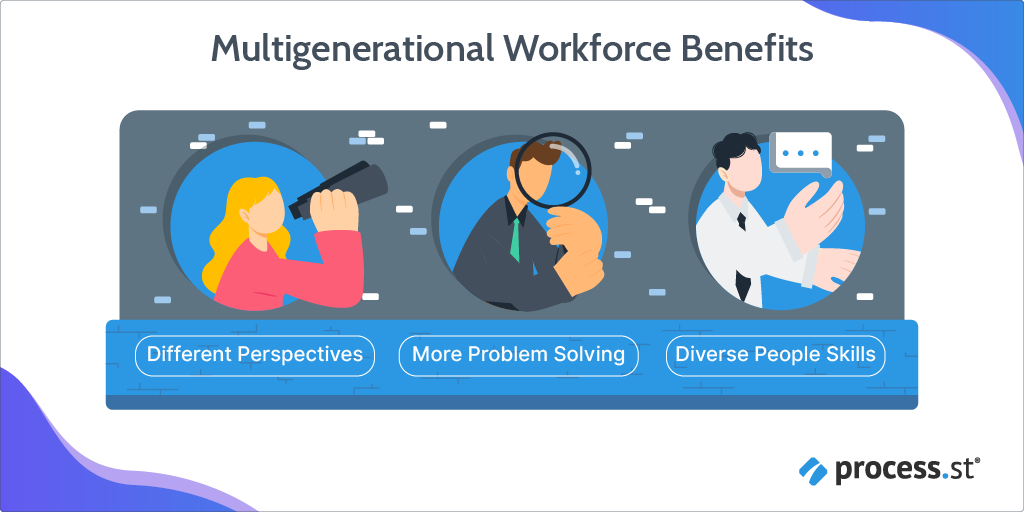
The three main benefits of a multigenerational workforce are:
- More problem-solving skills
- Different perspectives
- Diverse people skills
With different generations in your workplace, you will see more problem-solving. Each generation can bring its unique perspective:
- Generation X is good at identifying and developing new talent in their organizations.
- Generation Y has been exposed to smartphones from an early age and is good at learning new software and using it to implement new processes.
- Baby Boomers are great problem solvers due to their years of experience. They also make great mentors, as they are from a generation that has seen it all in terms of economic booms and recessions.
Simon Sinek, a leadership expert, gives his views on mentorship:
Reverse mentoring is a new and popular perspective on mentorship. Younger members of your team can assist older team members. One way to boost productivity is by learning new technology. For example, you could have a staff member from Generation Y or Z (often referred to as digital natives) showing a Baby Boomer how to use online workflows and knowledge base software.
The different perspectives of the generations are critical and will help avoid the presence of egocentrism in the workplace. Each generation realizes that not everyone sees an issue the same way. A multigenerational workforce will give a good mix of perspectives based on different life experiences. As a result, your organization will experience greater innovation and creativity.
Diverse people skills are also an advantage in dealing with customers. Each generation has its favorite way of communicating, as the list below shows:
- Traditionalists: Prefer face-to-face communication, letters, and phone calls
- Baby Boomers: Open to contact via email, letters, voicemail, and face to face
- Generation X: Email is their preferred form of communication, and conversations are short
- Generation Y: Prefer internet communication and expect prompt feedback
- Generation Z: Like instant communication across multiple screens with images
This mix of employee communication styles will help attract and retain customers of all ages. For example, older customers might prefer you to send a letter instead of an email. The Traditionalists and Baby Boomers in your workforce will be able to show younger employees how to do this effectively.
Multigenerational workforce challenges
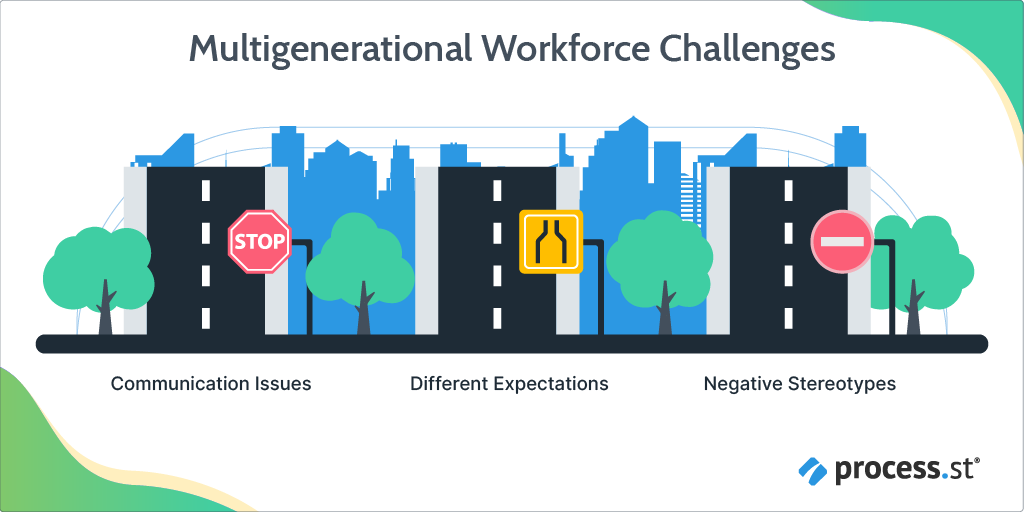
The three main challenges of a multigenerational workforce are:
- Communication problems
- Different expectations
- Negative stereotypes
Communication problems can cause small businesses of up to 100 people around $420,000 annually. That’s the cost of miscommunication, such as email blunders. With the cost of misunderstanding being expensive, how can you optimize communication and make it engaging?
Workflow software is one of the best options; it gives information visually and in an easy-to-follow process.
An optimized workflow takes a user through a process using a series of tasks. For ease of use, the tasks are in numbered order. Your business processes can all be simplified. For an example, take a look at the Leave of Absence workflow below:
You can also include emails, Word documents, images, and videos in your workflows. That will help to engage the whole of your workforce, regardless of which generation they belong to.
Different expectations
Differences in life expectations and differing value systems may cause problems for your multigenerational workforce. Each generation is at a different stage in its life, and this will affect their day-to-day decisions. A suggestion to overcome these issues is using inspirational motivation techniques.
You could try using theory z by Dr. William Ouchi to make employees more engaged and bring them together.
Theory Z encourages employee engagement by using:
- Mutual trust and openness
- A strong bond between the organization and employees
- Collective decision-making
- Free-form organizational structure
- Role of facilitator and coordinator for management
- Common culture
- Informal controls
- Human resource development
Negative stereotypes
From my experiences working in social housing, I understand that some people have negative stereotypes about homeless people. Our life experiences also play a role in creating stereotypes. In unconscious bias, people take stereotyping one step further and look for evidence to prove their bias and stereotypes are true. Perspectives, once formed, can be challenging for people to question.
To combat negative stereotypes, you can implement diversity and inclusion training. Diversity and inclusion are values we believe in at Process Street. We have also created custom-made templates to assist organizations who want to take this step. If you’d like to use the templates, they are listed below. To use them, all you need is a free Process Street account:
Unconscious Bias Training Guide
Diversity in the workplace can be a positive outcome; studies have shown that diverse teams outperform homogeneous teams. Using workflows to help train in areas such as diversity is a great idea and fosters employee engagement. It’s easy to create a workflow, see the video below to see how it’s done:
Five tips for engaging a multigenerational workforce
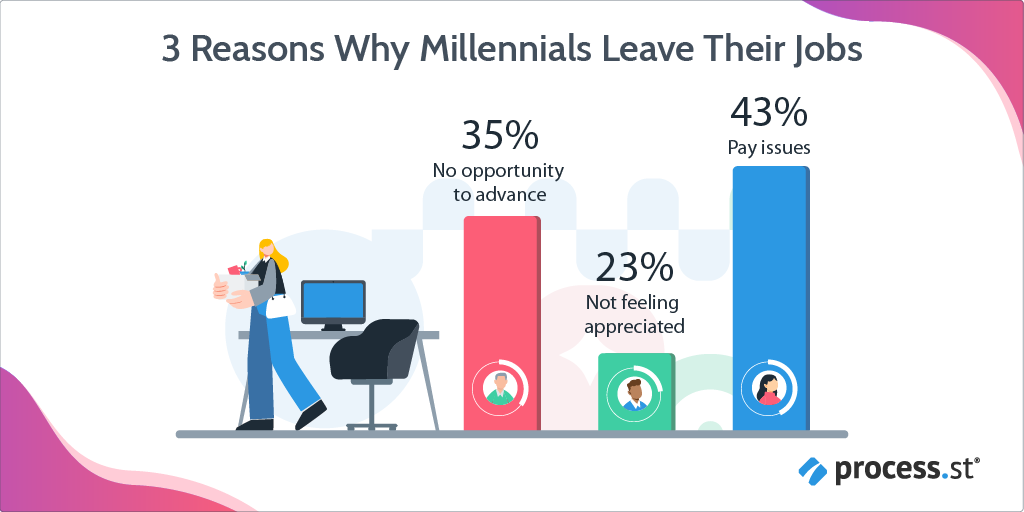
Consider using these five tips to engage your multigenerational workforce:
- Use BPM to improve communication
BPM (business process management) is great for increasing speed and efficiency, making it ideal for improving communication. If you divide your organization’s processes into step-by-step tasks, you make them available and usable by every generation. As a series of tasks, workflows also come with the ability to add comments to every task. Every generation can use them and communicate why they have chosen to complete a task.
You can also use BPM to create policies welcoming to all generations. Why not store them on our free forever product known as Pages? A 24-7 online knowledge base, Pages can store all your documents, including SOPs, ISO processes, Approvals, and onboarding documents. Your documentation can be printed or accessed on devices such as smartphones. If you have fewer employees, workflows are a great productivity app to utilize.
- Offer reskilling opportunities
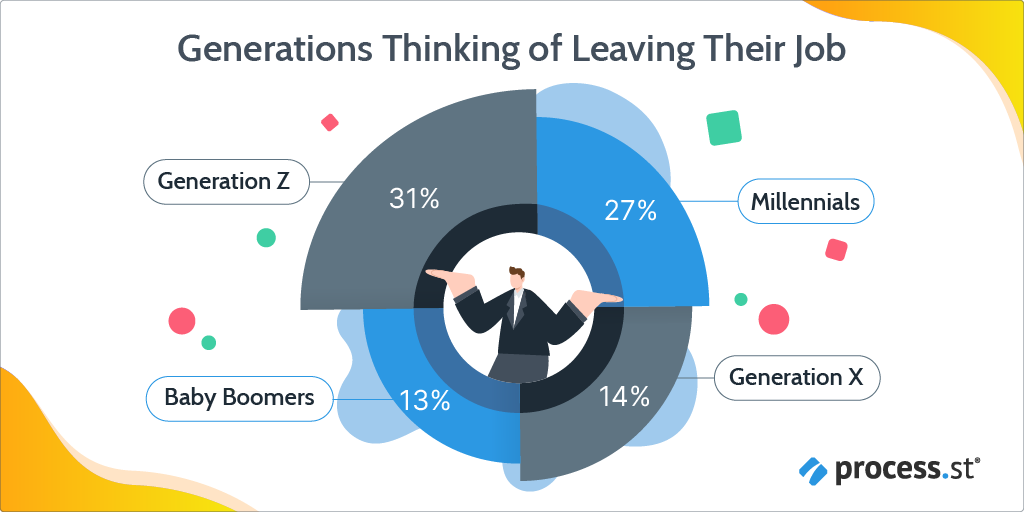
You can offer reskilling opportunities to all generations of your workforce. As business change is a daily process, training should always be at the top of any daily checklist. To encourage staff members to reskill, you can make the process easier using workflow management.
At Process Street, we created a workflow to teach employees how to take care of their computers. If you’d like to see what we came up with, please help yourself to the Computer Maintenance Guide workflow. The workflow can be stored in Pages and repeatedly used, eliminating the need to store paper files. To see how Pages can store all of your documents, please see the video below:
- Provide upskilling training
You can determine which of your employees to upskill by making an aptitude test. To guide you through this process, we’ve created a workflow for you.
Try our IQ Test (Structure Template). This workflow will help you analyze your workforce to find those who can be made better use of, regardless of age. By encouraging training, you will help to engage your multigenerational workforce.
- Use workflows to collect feedback
To help employees of all ages feel listened to and understood, collect feedback using anonymous survey workflows. Allowing your staff freedom to discuss uncomfortable issues such as workplace conflicts can make every employee feel understood and engaged.
Please try using our Employee Satisfaction Survey workflow. Getting started with Process Street is easy if you want to try using workflows to make your work easy. We have almost a thousand ready-made workflows to help get you started.
- Encourage team collaboration
A workflow app encourages team collaboration by offering easily understood features to any staff member. With the ability to comment on workplace tasks, workflows eliminate miscommunication between different generations. Employees can also add videos and custom branding or upload documents and photographs to make communication clearer than it has ever been. Traditionalists and Baby Boomers can upload letters.
Generation Z can also complete a process and show how it was done by including additional images. With no-code software, team collaboration can be made quicker. You can find all this and more at Process Street.
The famous butler who was an expert in exports
I once saw a security guard in tears. At 55, he was a recipient of forced retirement. I then thought of Bill, who worked in my department at the time, and was 83 years old. I wondered why Bill was still in a job?
Bill had been Marlene Dietrich’s butler, and the rest of his working career was said to be as enjoyable. His experience brought the export company millions each year, and they couldn’t function without him.
Have you used our information to engage a multigenerational workforce, or do you have any other tips you’d like to share? Please let us know your thoughts in the comments below!







 Workflows
Workflows Forms
Forms Data Sets
Data Sets Pages
Pages Process AI
Process AI Automations
Automations Analytics
Analytics Apps
Apps Integrations
Integrations
 Property management
Property management
 Human resources
Human resources
 Customer management
Customer management
 Information technology
Information technology



Mark Jones
Mark Jones is a content writer at Process Street.